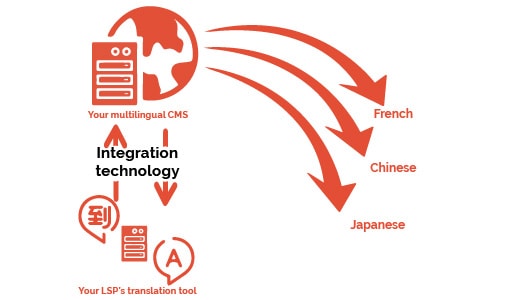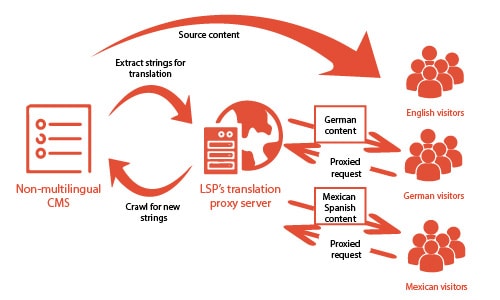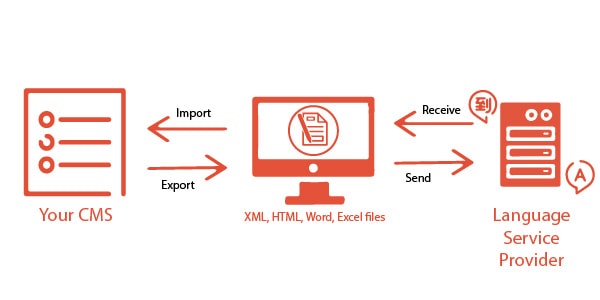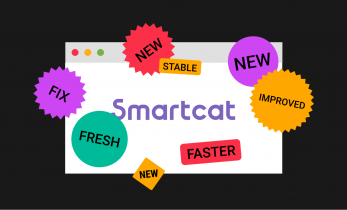Greater than 5 minutes, my friend!
Website localisation: Should you integrate with your client? How to advise properly your clients and prospects on system integrations
If you are planning to penetrate international markets you will, at some point, face the challenge of website localisation. Having your content available in the local language of your target markets will help increase visibility and brand awareness, but also directly impact your export sales. Especially in the case of online-based businesses.
Website localisation will bring up a few hurdles on the way, such as choosing the best international domain structure, international SEO , system integration, and more aspects. Depending on your localisation strategy, business goals and the level of effort you are willing to put in, you will have to carefully evaluate your options for each of these steps.

What is website localisation integration?
If you are looking at initiating a professional website translation with a language service provider (LSP), you will be provided with different options. In a simple way, you’ll have the choice between website localisation integration, integrating your website multilingual versions with your LSP’s translation tool, or keeping things separated.
Depending on which system you are using to manage your web content and how often you update it, you will consider your options accordingly. Be mindful that the method you select will also define processes and functionalities within your website localisation workflow. So you’ll want to weigh your options carefully to choose the one that best meets your localisation needs and business requirements.
What to consider before integrating your CMS with your provider
As you consider the option of website localisation integration, you will want to answer these questions:
- Do you create, review, and approve your source-language content directly within your CMS platform?
- Is there someone in your company who will manage the website localisation process with your LSP, or is that a new responsibility for your team?
- What is the usual update cadence for your website’s main content types?
- How quickly are you required to publish those updates in foreign languages?
- Is it necessary that your translated content goes live simultaneously across multiple language sites?
- Is your CMS a candidate for integrating with your LSP’s translation management system via integration technology?
- To what extent can your CMS be described as having multilingual content management capabilities? (True multilingual content management means more than supporting the Unicode standard. It includes the ability to synchronize the same content across a multitude of languages—among other key functionalities).
Integration of your CMS with your service provider
Integration technologies enable you to transfer seamlessly content from your CMS system to your LSP for translation. By connecting your CMS to your LSP’s translation management tool and creating content transfer automation, you will be able to streamline your workflows and gain process efficiency.
Most of the modern CMS systems will have a number of integrations available. Some integration technologies enable clients to automate the selection, transfer, retrieval, and monitoring of content for localisation from within your multilingual CMS itself. For example, the popular CMS WordPress via its plugin WPML allows various website localisation integration possibilities.
How does it work?
CMS Integration technology is usually built in one of two ways (or a combination of the two): Plug-in-based solutions reside as extensions within your CMS, whereas middleware-brokered versions live outside your CMS—yet interact with your content in a variety of ways.

When your content is ready for translation you can send it to your LSP via the plugin or the integration’s user interface. Once the content is translated/localised, it is then re-imported back into the right spot in your multilingual CMS, where it can be published.
Is it right for me?
CMS integration technology is particularly relevant when you are managing large amounts of publications or lots of dynamic content in various languages that require fast time-to-market and regular & fast site updates. It also makes sense for CMS systems managed by a large number of stakeholders, such as contributors, editors, content owners. If your CMS is multilingual friendly, talk to your LSP to integrate it with their translation system.
Can I still integrate if my CMS system is not multilingual friendly?
If your CMS doesn’t support multilingual content, you might want to take another approach to your localisation workflow; technologies such as translation proxy allow you to reach a near website localisation integration experience. This cloud-based technology enables your LSP to create and manage consistent websites in various languages. The translation proxy server sits between your main website and global audiences. Traffic from your localised sites is directed through the translation proxy when site visitors request pages in other languages.
Translation proxy server
The LSP’s translation proxy server software crawls your website like a search engine would do, ingesting strings of text and XML/HTML page code. The strings are queued for localisation in the LSP’s translation management system. The translated strings are saved on the proxy server and served from there to the global audience.

This approach is best if you have standardised non-dynamic content that changes frequently. It allows fast time-to-market, with very minimal design, development or management from your end. Because the proxied versions of your site are mirrored versions, the possibilities for localisation and customisation is little to none. This also involves a close management by the LSP and will incur additional costs.
Website localisation without integration with your LSP
Sometimes website localisation integration is just not worth it for your particular case or simply not relevant to your business. If you wish to keep your CMS apart from your service provider’s translation system or the multilingual integration options are very limited, you’ll have to look into other workflows to achieve website localisation.
Manual file transfer
The most common and low-tech approach is to manually extract files (HTML or XML) from your CMS to send them to your LSP for translation. You’ll retrieve the file in the same format and will have to upload it to the appropriate location yourself. In rare cases, when your CMS doesn’t have an export functionality, you will have to copy and paste content into a Word or Excel file.

This labour-intensive approach doesn’t allow any kind of automation and leaves more margin for error as the human component has a greater impact. However, it will give you a greater control over publication and costs.
Is it right for me?
Manual file transfer is relevant if you are using a custom built CMS that doesn’t support other languages and when you only have 1 or 2 localised versions. If time-to-market is no concern for you and your website is relatively small with infrequent updates, this solution could be right for you.
Fully outsourcing your global website operations
Global website management is a solution that enables you to completely outsource the operational component of your multilingual global sites. Depending on your requirement this includes a set of services such as translation, localisation, global digital marketing and social media marketing, content creation and publication and operational responsibility for your brand’s online global presence.

With this set-up, your LSP assumes the responsibility to managing all of your global website versions (including localised digital marketing, when required) from content creation to go-live distribution.
Is it right for me?
By fully outsourcing the resources for multilingual websites and digital marketing for local markets you reduce or eliminate the need for allocated internal staff. This could be good for you, if you are not familiar with localisation and need industry specialists assistance. If you choose this option, you might want to do some research when searching for an LSP. This requires a certain level of maturity from the language service provider’s side because only some select organisations can deliver the language, cultural, strategic marketing, and technical expertise required to completely manage your global sites and campaigns, and a smooth coordination between stakeholders.
Choosing the right website localisation method will have a great impact on your online localisation success, doing a thorough pre-research based on the factors and options listed above will help you make the most adapted choice for your business.
What about you translators? Do you have any experience working with the setups described above? Feel free to share your experiences and thoughts in the comments!





